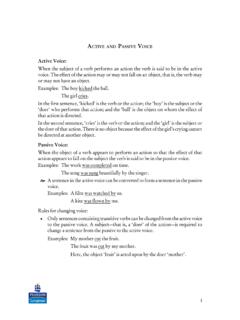Transcription of GENDER IN TELEVISED SPORTS - University of Southern …
1 1 GENDER IN TELEVISED SPORTS NEWS AND HIGHLIGHTS SHOWS, 1989 2009 CO INVESTIGATORS Michael A. Messner, University of Southern California Cheryl Cooky, Purdue University RESEARCH ASSISTANT Robin Hextrum University of Southern California With an Introduction by Diana Nyad Center for Feminist Research, University of Southern California June, 2010 2 TABLE OF CONTENTS I. INTRODUCTION by Diana II. SUMMARY OF III. DESCRIPTION OF IV. DESCRIPTION OF 1. SPORTS news: Coverage of women s SPORTS plummets 2. ESPN SportsCenter: A decline in coverage of women s SPORTS 3. Ticker Time: Women s SPORTS on the margins 4. Men s Big Three SPORTS are the central focus 5. Unequal coverage of women s and men s pro and college basketball 6. Shifting portrayals of women 7. Commentators: Racially diverse; Sex segregated V.
2 ANALYSIS AND INTERPRETATION OF VI. VII. APPENDIX: SELECTED WOMEN S SPORTING EVENTS DURING THE VIII. BACKGROUND AND PURPOSE OF THE IX. X. ABOUT THE CO 3 I. INTRODUCTION By Diana Nyad For two decades, the GENDER IN TELEVISED SPORTS report has tracked the progress as well as the lack of progress in the coverage of women s SPORTS on television news and highlights shows. One of the positive outcomes derived from past editions of this valuable study has been a notable improvement in the often derogatory ways that SPORTS commentators used to routinely speak of women athletes. The good news in this report is that there is far less insulting and overtly sexist treatment of women athletes than there was twenty or even ten years ago. The bad news, in these times of women s empowerment and success in most spheres of our society, is that the overall coverage of women s SPORTS has declined to a level of outrageously small numbers.
3 As a former world class athlete, and through my thirty years working in SPORTS television and radio, I have certainly come to know the uphill challenges we women face in the male bastion of SPORTS . I am also fully aware of the market forces at work in shaping the everyday programming decisions in TELEVISED SPORTS . But in reading this most current edition of GENDER IN TELEVISED SPORTS , I confess to being shocked to learn that since 1989 very little has changed in the world of TELEVISED SPORTS news. As a matter of fact, for women athletes, and fans of women s SPORTS , things have devolved, rather than having evolved. It is frankly unfathomable, and unacceptable, that viewers are actually receiving less coverage of women s SPORTS than they were twenty years that the SPORTS news is still being delivered almost exclusively by men.
4 There is no doubt that there has been a GENDER revolution in American SPORTS in recent decades. Millions of girls play SPORTS every day. Tens of thousands of women compete in college and professional athletics. Women s athletic skill levels have risen astronomically over the past twenty years in SPORTS from basketball to volleyball, from swimming to soccer. It is time for television news and highlights shows to keep pace with this revolution. I can only hope that, five years from now, when this study is conducted again, it will find a substantial number of women among the ranks of SPORTS news and highlights commentators, and that they, along with men commentators, will have joined the Twenty first Century by reporting fairly and equitably on women s SPORTS . The coverage today misrepresents both the participation and the interest in women s SPORTS across our population at large.
5 Diana Nyad is formerly a commentator with Fox SPORTS News and ABC SPORTS , and currently contributes a weekly column for National Public Radio. 4 II. SUMMARY OF FINDINGS COVERAGE OF WOMEN S SPORTS : LOWER THAN EVER Women s SPORTS were underreported in the six weeks of early evening and late night television SPORTS news on the three network affiliates sampled in the study. Men s SPORTS received of the airtime, women s SPORTS , and GENDER neutral topics This is a precipitous decline in the coverage of women s SPORTS since 2004, when of the airtime was devoted to women s SPORTS , and the lowest proportion ever recorded in this study. ESPN s nationally TELEVISED program SportsCenter devoted only of its airtime to coverage of women s SPORTS , a decline in their coverage of women s SPORTS compared with 1999 ( ) and 2004 ( ).
6 ESPN and two of the network affiliates (KNBC and KCBS), continually ran a scrolling ticker text bar at the bottom of the screen, reporting scores and other SPORTS news. The proportion of ticker time devoted to women s SPORTS on KNBC and KCBS was , more than triple the thin airtime they devoted to women s SPORTS in their main broadcasts. SportsCenter devoted of its ticker time to women s SPORTS , down from in 2004. MEN S BIG THREE SPORTS : IN OR OUT OF SEASON, ALWAYS THE CENTRAL FOCUS 100% of the SportsCenter programs and 100% of the SPORTS news shows in the sample led with a men s SPORTS story. Lead stories tend to be among the longest stories in the broadcast, containing the highest production values. 72% of all airtime (main and ticker coverage) focused on men s basketball, football, and baseball.
7 Other men s SPORTS , especially most individual SPORTS , were pushed to the margins along with the few women s SPORTS that received any coverage. Reporters continually devoted airtime to men s SPORTS that were out of season pro and college football in March and July, pro baseball in November, or pro basketball in July while failing to report on women s SPORTS that were currently in season. WOMEN S AND MEN S PRO AND COLLEGE BASKETBALL: SEPARATE AND UNEQUAL The WNBA received a tiny fraction of the coverage that was devoted to the NBA, both when in season, and when out of season. 5 College basketball in March is a sport being played both by women s and men s teams during the same time frame. The three network affiliate news shows devoted zero time, and SportsCenter gave token attention to women s college basketball, while lavishing huge amounts of air time to men s college basketball.
8 News and highlights shows scant coverage of pro or college women s basketball was usually relegated to the margins, appearing more often on the scrolling ticker at the bottom of the screen rather than in the program s main coverage. VIEWS OF WOMEN: LESS SEXUAL OBJECTIFICATION; SPARING SERVINGS OF RESPECT past studies observed that women athletes (and women spectators) were frequently portrayed in demeaning ways as sexual objects, or as the brunt of commentators sarcastic humor in stories on marginal pseudo SPORTS . There was far less of this sort of sexist humor about women in 2009, though this may in part reflect that women in any form were increasingly absent from the broadcasts. A large chunk of ESPN s SportsCenter s meager coverage of women s SPORTS was devoted to a short March series, Celebrating women s History Month: Her Triumph, Her Story.
9 These features had high technical quality, and were delivered in a respectful tone, but were cordoned off from regular SportsCenter highlights, and presented as something separate and different. A handful of women s SPORTS stories made their way into news and highlights shows when the story line was focused on a rule breaking incident like a fight, or on some other controversy in women s sport. On the rare occasions when women were featured in SPORTS news and highlights shows, they were usually presented in stereotypical ways: as wives or girlfriends of famous male athletes or as mothers. SPORTS COMMENTATORS: RACIALLY DIVERSE, SEX SEGREGATED past studies revealed that news and highlights commentators were racially diverse, but most were men.
10 This dual pattern of racial diversity and sex segregation continued in 2009. The three network affiliates included no women SPORTS announcers, while women announcers appeared in a small number of SportsCenter broadcasts. Unlike general TV news anchor or weather positions, the TV SPORTS news and highlights position is still defined almost exclusively as a male occupation. 6 III. DESCRIPTION OF THE STUDY As with the 1989, 1993, 1999 and 2004 studies, the central aim of the current study was to compare the quantity and quality of TV news and highlights shows coverage of women's versus men's athletic events. So that we might comment on change and continuity over time, we replicated the previous iterations of the study. First, we analyzed three two week segments (a total of six weeks) of TELEVISED SPORTS news coverage on each of three local (Los Angeles) network affiliates.













